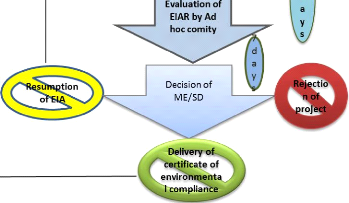3.1.2.3. Scoping
During this phase, the terms of reference (ToR) are elaborated
by the project developer in collaboration with the BEEIA in case an EIA is
deemed necessary. The ToR identifies the important environmental issues
including concerned populations opinion and guide the EIA so that
investigations and resources are focused on those aspects of the project that
are likely to produce significant adverse impacts. They are submitted by the
project developer to the ministry of the environment via BEEIA for approval.
3.1.2.4. Realisation of the EIA
This step is under the responsibility of the developer and is
conducted according to the (ToR). The developer conducts the inventory leading
to the description of the initial state of the biophysical and human
environment; identifies and assesses the impacts, carries out the choice and
analyses the alternatives, proposes mitigation and improvement measures,
develops an Environmental and Social Management Plan (ESMP) that defines the
monitoring conditions and elaborates the EIA report.
3.1.2.5. Review of Impact Assessment Report
The draft EIA report is submitted for a review to the BEEIA,
which has twenty-one days to review the EIA report and submits its results to
the minister of the environment. There are two types of reviews:
3.1.2.5.1. Internal Review
It aims to ensure that the content of the draft report
complies with the requirements of the ToR and that of Article 7 of the Decree
2000-397 on the content of an EIAR. It is conducted by the BEEIA which
transmits an admissibility notification of the report to the developer.
13
3.1.2.5.2. External Review
Two main activities are carried out for the purpose of the
external review.
y' The BEEIA conducts a field verification mission to compare
the information contained in the draft EIAR and the reality on the ground and
organises a public hearing to take better into account social concerns. This
activity leads to the elaboration of a field and public consultation report.
y' In the meantime, an ad-hoc committee composed of the
project' stakeholders is set up by the minister of environment via BEEIA to
examine the quality of the EIA report at a workshop to be organised for that
purpose. The field and public consultation report elaborated by the BEEIA is
also presented during the workshop.
3.1.2.6. Authorisation of Project
At the end of the workshop, the BEEIA reports the results of
the EIA procedure to the minister of environment within seven days from the
date of receipt of the ad-hoc committee's meeting report. The final decision is
supported by the field and public consultation and the ad-hoc committee meeting
report. On the basis of these reports, the decision will either be an
authorization (issuance of the Certificate of Environmental Compliance) for the
implementation of the project or a rejection of the EIAR, hence its resumption
with new ToR.
3.1.2.7. Monitoring Conditions
Monitoring conditions are the responsibility of the developer,
the CA and the BEEIA. Prior to the implementation of the project, the CA
identifies the impacts that need to be monitored as well as the relevant
indicators. It will also specify the schedules for monitoring and evaluation,
people responsible for follow up and the measures to be taken in case negative
impacts would exceed expectations. As a result, the project developer submits
to the BEEIA the ESMP that allows the elaboration of the environmental
specifications and an agreement to be signed between the project developer and
the BEEIA. Figure 3 below outlines the EIA administrative procedure in
Niger.
10
days 2 days
J
)
Project
Notification
screening
BEEIA
r,ppreciatjon: MESD

Figure 3: Administrative Procedure of Environmental
Impact Assessment in Niger
|
Preparation of TOR by developer in collaboration
with
BEEIA
|
Approval of TOR
by the
MESD/BEEIA
Realization of EIA and production of EIA report
(EIAR)

Admissibility assessment of EIAR by BEEEI
Lessons
learned J
W
implementation of project J
Monitoring and
control of ESMP
by
BEEIA
Implementation of
ESMP by the Developer
I
3--_
Autorization

Evaluation of
EIAR by Ad
hoc comity
Delivery of
ificate of
enviro enta I complian e
14
Source: Translated and adopted from Cisse
(2016)
15
| 


